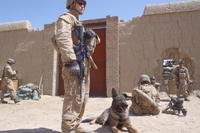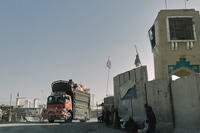The opinions expressed in this op-ed are those of the author and do not necessarily reflect the views of Military.com. If you would like to submit your own commentary, please send your article to opinions@military.com for consideration.
The women. We saw them but rarely engaged. With few exceptions, their burqas enveloped them from head to toe. I was familiar with middle eastern abayas. I knew some cultures or religions required women to be covered in black fabric except for their eyes. But in Afghanistan, when I was there in 2004, their burqas included a blue mesh screen that obscured the women's eyes.
This piqued my curiosity. I could sometimes secure permission to go outside the wire. When I could tag along on a military police mission or a supply run to Kabul, I took photos from afar, admiring the bright pop of burqa blue against the austere Afghan landscape.

While in Kabul, I found a pamphlet advertising Kabul dolls. They were beautiful dolls dressed in intricate costumes representing different Afghan ethnic groups. The cloth dolls even had individual fingers and toes. I was so impressed with the artistry that I contacted the company.
I was taken aback when they asked me to help sell them at Bagram Air Base. A man may have run the Kabul dolls company, but the business had been founded to help women, many of whom were war widows with no other options to make a living.
Several soldiers in my unit were granted permission to visit a town bordering Bagram on Christmas Day. We went into town eager to have something to do for the holiday besides eating mess hall Christmas dinner, sneaking alcohol with the Czech soldiers, or sitting in our tents. One of the female soldiers had ordered jackets and other small gifts.
The villagers received us politely but with some puzzlement. I'm sure they had heard of Christmas, but to them, it was just another day. But the women -- there wasn't a burqa in sight.

During the festivities, they invited me along with two other women soldiers into the women's quarters of one of the residences. We took off our shoes and marveled at the honor of being allowed into this private space. We didn't linger, well aware our presence might be viewed as an intrusion.
I worked as an interrogator in Afghanistan. I spent 12 hours a day interviewing male detainees at the Bagram Detention Facility. Then one day, I interrogated the only woman prisoner at Bagram. As far as I had known, there were no women prisoners.
At first, there was a flurry of outside interest in the prisoners, and the U.S. government made an intense effort to mine intelligence. But frequently, no intelligence was forthcoming, and they maintained their innocence. When this happened, sometimes months went by before the prisoner was judged safe to release. Some were terrorists, of course. But many had been picked up in sweeps where quantity over quality seemed to be the rule.

The exit interview was perfunctory. We sat in a small booth with a glass window and talked. She, the only female detainee at Bagram, sat before me shackled and dressed in a baggy orange jumpsuit and oversized black slip-on tennis shoes, while a bored MP stood guard. The middle-aged woman who sat in front of me did not strike me as an Afghan Mata Hari. She was open and chatty, guileless. She offered up a few words of English. I was no psychiatrist, but she appeared to have some mental health issues that detached her from reality. Intelligence gathering depended on detecting irregularities.
She seemed no more concerned that she had been sitting in a detention facility for more than a year than if she had been caught in a traffic jam. She had lost her figure since being in prison, she said. She did not mention missing her family or home, which made me wonder if her unconventional behavior had caused her family to abandon her: walking around without a male escort, speaking to American soldiers.
I attempted to make this a celebratory event. An interpreter translated while she ate the cookies and didn't drink the sh---y tea. She accepted the food I brought -- Afghan food from an officer's going-away party, so basically leftovers.
The tea was a disaster. I had misjudged the ratio of tea leaves to liquid. I was used to dipping Lipton's bags in hot water. The American way. Here, tea making was an art. She winced after she took a sip. We switched to bottled water.
She had suffered enough.
The verdict? Not a terrorist. Just a “high value” target our government had seen fit to keep for 400-plus days. Finally, she was being released. However, with no information about where she was from, only where she was arrested, where or what was she going back to?
When the command sent me to Asadabad, I was excited to be away from the flagpole. The post was in Kunar province, in the Hindu Kush mountains. The misty blue of the surrounding peaks, clear air, and relative quiet was a welcome respite from Bagram's hustle and bustle.
The Provincial Reconstruction Team seemed to prioritize local women's issues. The first event I attended was a women's shura -- a meeting -- where we were presented with white headscarves to wear instead of our Kevlars.
At an International Women's Day ceremony, we were honored as local service members helping the community. But we hoped the emphasis would remain on the Afghan women. They took the most risks by speaking out and advocating for women's equality. We were only doing our jobs.
In Asadabad, the PRT handed out approximately $50 each to women in the community to help them buy supplies to make handicrafts that could make money for their families. Many of these women were skilled in embroidery and needlework. They had to come in person to pick up the cash.
Inevitably, the women would try to give us gifts at the end of each event. We discouraged gifts because the money distributed by the Americans was supposed to go toward bettering the community. But it was considered rude to reject the gifts.

As with any project designed to win hearts and minds, I can't deny the money's intent was to curry favor and give the community a good impression of the Americans. Still, some Afghan people seemed to feel actual goodwill toward the Americans. But not all: An IED exploding nearby, captured insurgents, or rocket attacks on the forward operating base could jolt us back to reality.
Before I left the PRT, a local woman honored us with a luncheon at her house. We enjoyed delicious food, and she made a point of inviting the women members of the team into the women's quarters afterward.
I felt more comfortable in Asadabad than Bagram. We could walk in the mountains that fell inside the base, where we often encountered locals, mainly children. One time, I met two lovely young girls I took to be sisters. They reminded me of my own two daughters, whom I had not seen in many months. I still have the photograph I took. I longed to stay, but it was not up to me. Soon I was headed back to Bagram, and within a couple of months, I redeployed to the States.
I will never forget the women I met in Afghanistan: a local woman's leader, a suspected terrorist unjustly imprisoned, the Afghan girls in my photo, villagers on Christmas day. I feel for all the Afghan people. But I feel particular concern for the women. Of course, my concern is specious. It's a convenient way to feel like I'm a good person without doing anything. I am free to disagree with what is going on in Afghanistan from the comfort of my living room. I think that, if it were up to me, things would be different. But they wouldn't.
When it comes to making statements about where women fit into this new version of Afghanistan, the Taliban resort to vague or evasive pronouncements. What do we do about the women? It's a question they cannot settle. But with what we have seen so far, we know they perceive women who think for themselves and have financial autonomy as threatening. We hear them say girls will not necessarily be forbidden to attend school. But many boys' schools have reopened since the Taliban took over. Most girls' schools remain empty.
As military members, we go where we are told. Understanding the mission is not a prerequisite, and questioning it is discouraged. But for me, at least, my intent was to do as well as I could within the military rules I was obliged to follow. I read articles and books to try to piece together the history of a part of the world never mentioned in any of my high school history classes.
When I left, I took home some fond memories, dolls, and rugs. That was it. I wish I could have done better. I wish we could have done better.
Editors Note: This article first appeared on The War Horse, an award-winning nonprofit news organization educating the public on military service. Subscribe to their newsletter















